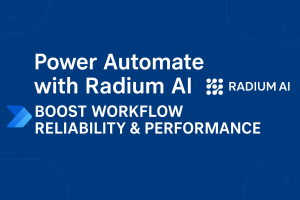“Welcome back, efficiency pioneers! Are you ready to turn ideas into action? Let’s get our hands dirty with process mining!”
We are back with the second chapter of our journey. This time, we move from theory to reality. You’ve learned why process mining matters, but now it’s time to learn how to do it. Grab your tools and coffee. We are about to unlock the magic of Microsoft Process Mining. This will change how your organization works!
Step 1: Understand Your Business Processes
Before you start with process mining, you need to understand your current business processes. This includes:
- Mapping Key Processes: Identify the most important processes in your business. These are the ones that can be improved, like finance, HR, supply chain, or customer service.
- Gather Data Sources: Collect all relevant data that can help you understand your processes. This includes event logs, transaction data, and user interactions. The more data you have from different departments and systems (like ERP, CRM, and HRMS), the better your insights will be.
- Engage Key Stakeholders: Talk to stakeholders in your organization to find pain points and areas for improvement. This ensures that process mining aligns with business goals.
Step 2: Integrate Process Mining with Your IT Ecosystem
With Microsoft’s process mining tools, the first step is to connect your IT systems to Microsoft’s Power Platform. This lets you pull the data you need and visualize workflows. Here’s how:
- Connect Event Logs and Data: Use Microsoft’s connectors to get event logs and system data. You can pull data from tools like Microsoft Dynamics 365, Office 365, and other applications. Integration with Power BI and Azure is also important for visualizing and storing large data sets.
- Set Up Data Recording Features: Use the recording feature to track user actions, app events, and transaction data. This is the foundation for your process analysis and improvements.
Step 3: Start the Discovery Phase: Visualize Your Workflows
The discovery phase is where process mining shines. In this phase, you can visualize your workflows from start to finish using the event logs and data you’ve gathered. Here’s what to do:
- Process Visualization: Use Microsoft’s Process Mining tool to see how processes are performed in real life. The tool uses event logs to create flow diagrams that show your business workflows.
- Identify Bottlenecks and Inefficiencies: Use process mining to find where delays or inefficiencies happen. This could include manual handoffs, decision points, or system downtime.
- Highlight Process Deviations: Look for any differences between actual workflows and the ideal ones. This helps you find compliance issues or gaps in the process.
Step 4: Run Conformance Checking to Ensure Process Compliance
After you create a visual map of your workflows, the next step is to check for conformance. This means comparing your actual workflows with the reference models you set up. This helps to:
- Detect Deviations: Find where processes are not being followed as intended or where unexpected bottlenecks appear.
- Ensure Compliance: Make sure your processes follow industry regulations or internal standards. Microsoft’s tools can highlight compliance violations automatically.
- Uncover Root Causes: By finding deviations and bottlenecks, you can investigate the root causes of inefficiencies.
Step 5: Analyze and Identify Automation Opportunities
Once you understand your processes, you can find ways to automate tasks. With Power Automate, you can trigger automation based on process mining insights:
- Automate Repetitive Tasks: Identify tasks that follow rules and happen often, like data entry or report creation. These tasks are great candidates for automation with Power Automate.
- Improve Decision-Making: Automate decision points in the process. Use set rules to trigger automatic actions. This saves time and reduces human error.
- Use AI to improve automation.
- Power Automate uses AI and machine learning.
- This makes your workflows more effective over time.
Step 6: Enhance Processes with Performance Mining
After finding inefficiencies and automation opportunities, use performance mining techniques to optimize your processes. By adding performance data, like execution times and resource use, you can:
- Analyze Time-Consuming Steps: Identify which steps take the most time and resources. You can then streamline or automate those steps.
- Optimize Resources: Find areas where resources are underused or overburdened, and adjust accordingly.
- Use Predictive Analytics:
Use insights from performance mining.
This helps you predict future problems.
You can fix bottlenecks before they occur.
Step 7: Simulate Process Changes Before Implementation
One powerful feature of Microsoft’s process mining is its simulation capability. Before making changes, simulate how those changes might affect the workflow. This allows you to:
- Test Improvements: Simulate different process changes to see how they impact performance.
- Predict Outcomes: Anticipate the results of your optimization efforts before implementing them.
- Make decisions based on data.
- Test changes in a controlled environment.
- This way, you can be sure they will work without interrupting the workflow.
Step 8: Automate and Continuously Improve
After making changes and optimizing workflows, it’s time to automate the process and keep improving.
- End-to-End Automation: Use insights from process mining to automate processes in real time. Whether it’s approval workflows or customer support queries, automation can be triggered based on data.
- Feedback Loop: Process mining is a continuous cycle. After automation, keep gathering data, finding new improvement opportunities, and optimizing processes. Use Power BI to visualize the success of your changes and gather feedback.
Step 9: Ensure Compliance and Governance
Finally, make sure all changes comply with industry standards and internal policies. Process mining helps you:
- Track Compliance: Use Microsoft tools to monitor and ensure that processes follow compliance regulations.
- Manage Risks: Identify risks from non-compliance and take corrective actions.
- Maintain Governance: Track changes in processes, results of automation, and performance metrics. This ensures good governance of your business processes.
Conclusion: Maximizing Automation & Process Optimization with Process Mining
In this chapter, we explained how to use Microsoft tools for process mining. We focused on Power Automate and Power BI. By following these steps, you can visualize your workflows, uncover inefficiencies, and optimize processes. By using AI to automate routine tasks, your business can run more efficiently. This saves both time and money.
The key to successful process mining lies in its continuous nature. As business processes evolve, so should your optimizations. With Microsoft Process Mining and Power Automate, you can use your organization’s data better. This leads to a more efficient and smart future. Keep the cycle of improvement going and watch as your operations transform into a model of efficiency and effectiveness!
A huge thank you for taking the time to read through this article and dive into the world of process mining with us!
Let’s not stop here—let’s stay tuned as we continue this exciting process of growth and learning. We are in this together. We are finding new insights and unlocking new possibilities. We are changing how we face challenges in automation and process optimization.
So, let’s stick together on this adventure, keep exploring, and keep learning—because the best is yet to come!








